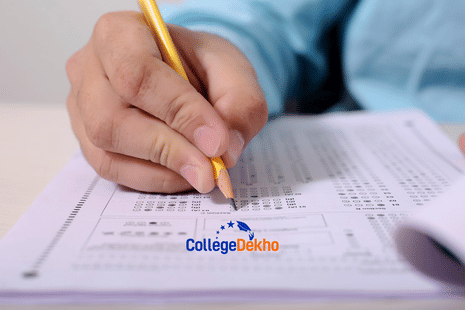
COMEDK UGET 2025 Electrostatics Practice Questions with Solutions:
Electrostatics is one of the important topics in the
COMEDK UGET 2025 Physics syllabus
. The chapter covers topics such as Electric potential, Equatorial surfaces, Conductors & insulators, and Combination of capacitors. Every year, a good number of questions are asked from these topics. In the upcoming
COMEDK UGET 2025 exam
, you can expect around 6-8 questions from Electrostatics. However, since the questionsa are majorly based on numerical calculations and formulas, it is important that you solve as many Electrostatics practice questions for COMEDK Physics paper as possible. While
COMEDK UGET previous year question papers
are a great tool for practice, we have compiled a few COMEDK Electrostatics sample questions with solutions here to help you prepare for the exam. These questions will help you gain clarity of concepts and improve your problem-solving skills.
Also Check -
COMEDK UGET 2025 Current Electricity Practice Questions with Solutions
Quick Links:
COMEDK UGET 2025 Electrostatics Important Topics
Before moving ahead with COMEDK UGET 2025 Electrostatics practice questions with solutions, you must ensure covering all the topics mentioned in the COMEDK Physics syllabus for detailed studies. In the following table, we have provided a list of all the subtopics for Electrostatics.
Chapter | Topics |
|---|---|
Electrostatics |
|
COMEDK UGET 2025 Electrostatics Expected Weightage
Knowing about COMEDK Electrostatics weightage will help you understand the importance of this chapter and even identify the areas that need to be more focused on. While the question paper changes every year and it can be tricky to predict how many questions will be asked from a particular topic. We can assess COMEDK past year question papers to help predict the expected weightage for Electrostatics:
Topic | Expected Number of Questions | Expected Weightage |
|---|---|---|
Electrostatics | 6-8 | 10-13% |
Also Check -
COMEDK Chapter Wise PYQs for Physics
Quick Links:
| COMEDK UGET 2025 Exam Date | COMEDK UGET 2025 Admit Card |
|---|
COMEDK UGET 2025 Electrostatics Practice Questions with Solutions
In this section, we have provided some of the most competitive and concept-based Electrostatics practice questions for COMEDK exam. You are advised to go through the sample questions and solutions explained below and practice similar questions using the COMEDK 2025 Physics formula sheet for top-notch preparation.
Q1. PQRS is square of side 1m. A charge of 100uC is placed at the centre of the square. Then the work done to take 3uC charge from the corner P to the corner R.
a. 0
b. 4.5 J
c. 1800 J
d. 1 J
Ans. a. 0
Solution: To find the work done in moving a charge from one point to another in an electric field, we need to first understand that work done is given by the difference in potential energy between the two points, which can also be interpreted as the potential difference times the charge being moved, i.e.,
Work = q.ΔV
where q is the charge being moved, and ΔV is the potential difference between the initial and final points.
For a charge Q placed at a point, the potential V at a distance r from the charge is given by Coulomb's law as:
V = k.Q/r
Where k is Coulomb’s constant.
In the case of the square PQRS with a charge of 100uC at the center and sides of 1m, the potential at any corner due to the central charge would be the same because all corners are equidistant from the center.
Since PQRS is a square of side 1m, the distance from the center to any corner (the diagonal of the square, which is half the diagonal of the square) is:
d = √2/2
The potential at any corner (or the work per unit charge to move a charge from infinity to that point) due to the central charge:
Q = 100uC = 100 X 10 -6 C is
V = kQ/d = 9√2 x 10 5 V
Since the potential everywhere along the path (any path on the square plane) from P to R due to the central charge is constant because the distance from each point on the path to the charge is constant, the potential difference ΔV between corners P and R is zero. Therefore, the work done in moving any charge from P to R is:
Work = q.ΔV = q.0 = 0.
Q2. The force between two electric point charges at rest in air is F 1 When the same arrangement is kept inside water, the force between them is F 2 . Which of the following statement is correct?
a. F 2 = 0
b. F 2 >F 1
c. F 2 = F 1
d. F 2 < F 1
Ans. d. F 2 < F 1
Solutions: The force between two point charges is described by Coulomb's Law, which states that the magnitude of the electrostatic force between two point charges is directly proportional to the product of the magnitudes of the charges and inversely proportional to the square of the distance between their centers. In a vacuum or air, this force can be given by the equation:
F = k|q 1 q 2 |r 2
where:
F is the magnitude of the force between the charges,
q 1 and q 2 are the magnitudes of the charges,
r is the distance between the charges,
k is Coulomb's constant
When the same arrangement of charges is placed in a medium such as water, the force between the charges is affected by the dielectric constant (ε r ) of the medium. The equation for the force in a medium becomes:
F’ = kε r |q 1 q 2 |r 2
where ε r is the relative permittivity (dielectric constant) of the medium. For water,
ε r is approximately 80 at room temperature. Because ε r > 1 for any medium other than vacuum, the effect of this is to reduce the force between the charges:
F 2 = F 1 /ε r
Hence, F 2 < F 1
Q3. Charge on an electron is
a. 3.2 x 10 -19 C
b. 1.6 x 10 -19 C
c. -1.6 x 10 -19 C
d. 3.2 x 10 -19 C
Ans. c. -1.6 x 10 -19 C
Solutions: The charge on an electron is negative and its magnitude is -1.6 x 10 -19 C.
Q4. Insulators can be charged by which of the following processes?
a. Friction
b. Induction
c. Diverging
d. Heating
Ans. a. Friction
Solutions: Insulators can be charged by rubbing or friction with another body. For example, or rubbing a glass rod with the silk gets negatively charged while the glass rod gets positively charged.
Q5. Work done in moving a charge of 25 C is 50 J. Calculate the potential difference, between two points.
a. 0.5 V
b. 1 V
c. 2 V
d. 2.5 V
Ans. c. 2V
Solution: Given, W = 50 J and q = 25 C
Potential difference, V = Work done/Charge
V = 50/25 = 2.
After solving similar practice questions from COMEDK Electrostatics chapter, you can move on to attempting
COMEDK UGET 2025 mock test
papers to test your preparation level and track progress so far. The more you practice now, the better you will be able to identify the questions and solve quickly, thus saving valuable time during the actual examination.
Related Articles
| Do or Die Chapters for COMEDK UGET 2025 Physics | Benefits of Solving COMEDK UGET 2025 Test Series for All Subjects |
|---|---|
We hope this article on COMEDK UGET 2025 Electrostatics Practice Questions with Solutions was helpful to you. For more such articles and the latest updates regarding COMEDK exam, stay tuned to CollegeDekho! For admission related queries, fill out our Common Application Form on the website.
Are you feeling lost and unsure about what career path to take after completing 12th standard?
Say goodbye to confusion and hello to a bright future!

Was this article helpful?





















Similar Articles
GATE CS Question Paper Difficulty Level Trends: A detailed analysis
JEE Main 2026 Chemistry High Priority and Low Priority Chapters
Are JEE Main Study Groups Worth It? Detailed Pros and Cons for 2026 Aspirants
How to Prioritize Physics Chapters Based on JEE Main 2026 Weightage and Difficulty
GATE 2026 Mechanical Engineering Expected No. of Questions Topic-Wise
GATE 2026 Civil Engineering Expected No. of Questions Topic-Wise